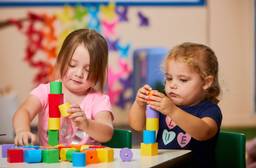How to build a PILES child development chart
Lesson planning in early childhood education usually follows five areas of human development that have different milestones for each developmental stage. A common framework that educators follow is called PILES which is an acronym for the domains.
Whether you are new to the field or a seasoned veteran, it is always good to reconnect with the basics through the PILES model. We’ll be taking a deeper dive into how to build a PILES developmental chart and align this with activity planning for your classrooms!
The five domains
So, what are the five domains? The acronym PILES stands for – physical, intellectual, language, emotional, social. These categories each represent a series of broad skills that children learn as they grow. By following the PILES model, educators can monitor how each child is developing and can support their development with daily activities that target specific skills that aid in a child’s overall development.
All early learning frameworks in Canada and the U.S. are based on the PILES model to support holistic early childhood development. Let’s have a look at each domain in more detail.
Physical

The physical domain focuses on the development of a child’s body. This includes changes in size, strength and physical maturity that contribute to gross-motor and fine-motor skills. Growth in this domain is the most rapid between ages 0-2. Did you know that the brain triples in weight during this time?
Activities to support physical development:
- Infants – tummy time to build neck and upper body strength, holding and grasping items for grip strength.
- Toddlers – block play for hand-eye coordination, walking around for balance and gross motor skills.
- Preschoolers – running and stopping for spatial awareness, drawing and writing for fine motor skills.
This domain is really easy to incorporate on a daily basis and is a ton of fun. Get moving and watch children grow!
Intellectual

The intellectual domain is also known as the cognitive domain. It focuses on how children process their surroundings and solve problems. Counting and math skills, organization, imagination and creative thinking fall into this domain.
Activities to support intellectual development:
- Infants – reading to them and pointing out simple shapes, colors, and counting things is helpful to help children understand these concepts.
- Toddlers – making and identifying shapes during play, organizing toys during cleanup by color, and encouraging them to count.
- Preschoolers – engage in simple mathematics such as addition and subtraction in daily routines as well as measuring things.
Young children are naturally curious, so it is really easy to get creative to engage them!
Language

The language domain covers a child’s speaking and reading ability as well as the size of their overall vocabulary. This will lay the foundation for a child’s literacy skills such as reading and writing. This is the most traditionally academic domain but that doesn’t mean it has to be boring!
Activities to promote language skills:
- Infants – read to them like you’re talking to them. Hold eye contact and use hand gestures to help infants understand verbal communication.
- Toddlers – read, sing, repeat! Allow toddlers to repeat their favorite songs and stories to you and encourage them to add to their statements.
- Preschoolers – engage preschoolers in the storytelling process by pausing to ask them to interpret what’s going on. Ask open-ended questions and have frequent conversations to help build their vocabulary.
Communicating with children is also a great way to solidify your relationship with them and get to know their little personalities. You never know how a child might surprise you!
Emotional

The emotional domain is all about building an emotional connection, identifying, processing and expressing feelings. This is arguably the most difficult domain as adults sometimes struggle with this! A good place to start is by developing the language to talk about emotion and modeling positive emotional responses for young children, especially in real-time situations.
Activities to promote social-emotional development:
- Infants – exaggerate your facial expressions and enthusiasm when interacting with infants and model empathy.
- Toddlers – offer toddlers specific language to help them identify their emotions as they are happening. Describe how a character in a book or show is feeling to help them relate.
- Preschoolers – encourage conversations around why a child feels a certain way. Model mindfulness and self-awareness to show different ways to feel better.
Create a space where a child is able to express their feelings and develop their emotional intelligence. A lot of this work happens spontaneously rather than planned so being adaptable is key.
Social

The social domain involves social interactions with their peers. Surprise!
Similar to emotional development, educators need to be adaptable to the situation and encourage healthy conflict resolution and helping children understand their place in a community.
Activities to promote social development:
- Infants – babble to them and encourage responses. Engage in eye contact to help them associate it with communication.
- Toddlers – encourage group play and positively reinforce when children are being kind to one another. In the event of a conflict, help children communicate their boundaries using words instead of hitting.
- Preschoolers – model cooperation and empathy. Help children develop their confidence by encouraging group activities.
Allowing children to interact organically while observing them is a good way to notice how they’re developing and whether they need individualized support.
The role of an early childhood educator
As educators, it’s important to understand which skills your activities are targeting and to develop routines that cover the five developmental domains in the PILES model. Many activities may involve more than one domain and it’s totally fine to focus your observation on one instead of all of them! Our post on the history of early childhood education explains the different early childhood education curricula and approaches available and the influences that have shaped the field into what it is today.
The key thing is to engage the kiddos in each activity and notice how they’re responding. Games like hide and seek, playing with building blocks and group reading all stimulate different areas of a child’s brain and aid in their overall development.
Using a childcare app for documentation
Keeping track of a busy classroom can be difficult without the right tools. A childcare app can be helpful to document observations in real-time and reflect on them during quiet time.
This way, it is easier to visualize how each activity is contributing to the development of specific domains and tailor lesson plans around this. Organized documentation also helps early educators work together as one unit.
Learning stories are a great way to communicate each child’s growth to their parents and connect their learning to the home. Parents can expand on classroom activities by talking to their children about their experience and engaging in similar activities at home.
Interested in learning more? Book your free consultation with a HiMama Community Advisor to see how we can help you!
Related Posts
- Activities to Promote Preschool Cognitive Development
- What is Developmentally Appropriate Practice?
- Integrating Physical Activities for Toddlers into Your Schedule
- Preschool Literacy Activities to Encourage Cognitive Development
- How to Build a Curriculum for Daycare
Download our ebook with tips on how to observe children in the classroom!
Dylan Copland
May 28th, 2020
11 mins
Related Articles

Preparing your Childcare Summer Camp Program
April 16th, 2025 | Maddie Hutchison



